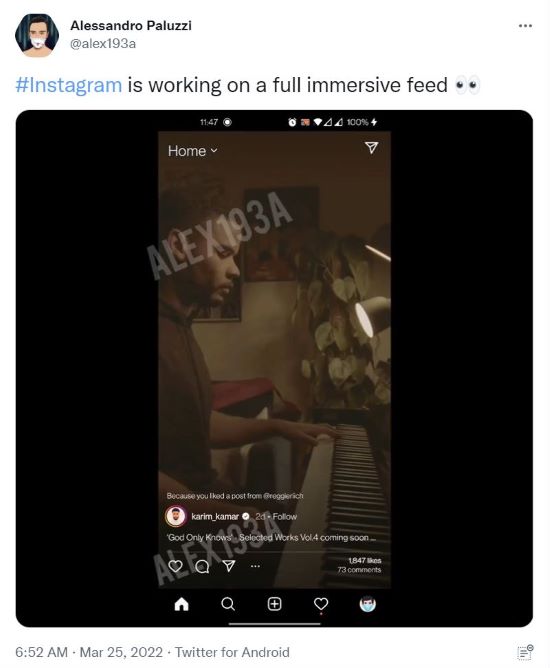Instagram Testing Reels and Stories in Feed [Advertisers Chime In]

For the hundreds of millions of us that are active on Instagram daily, it can be hard to imagine a layout that doesn’t position Stories at the top of our feed. But that reality may come to light sooner than we thought as Instagram has begun testing an immersive, fully-integrated home feed that would include all Instagram content types—Posts, Stories, and Reels—in the same swipeable screen.

If that social layout sounds familiar, it’s for good reason; Instagram appears to be taking some heavy design cues from TikTok. And to be fair, that is probably not a bad idea. After all, if you’re going to steal your look from someone in your class, it’s smart to choose one of the most innovative, trend-setting, popular kids, and TikTok fits the bill.
As SocialMediaToday notes, the official rollout hasn’t yet begun, but is expected to in short time:
“This is a back-end prototype at present, which might still not see the light of day. But it probably will, and given the state of its development, as shown here, I’d be expecting to see this soon, giving users a whole new way to engage with all of Instagram’s different content formats, while also aligning with the platform’s stated push on video content.”
We sat down with Avi Ben-Zvi, VP of Paid Social at Tinuiti, to chat through his take on the potential changes, and why and how the update might impact brands and advertisers…

In Meta’s Q4 earnings call, one of the big storylines was the fact that TikTok was mentioned by name a couple times. Historically, Meta has not mentioned a competitor before, so it was really indicative of the success TikTok has achieved in such a short time.
Additionally, they mentioned they are trying to appeal to a younger audience across their properties, including Facebook, Instagram, and Messenger. The user base on Facebook properties has been aging up over the last few years, especially as they reach audience saturation across the world. We’re seeing a major shift towards basically what TikTok is doing—this sort of discovery-oriented, vertical video that dominates the whole screen. This is opposed to a pure social feed, where Stories and Reels sort of live in their own environments, and the feed itself is still the core part of the app.
The integrated layout changes are at least partly a response to the fact that advertising on Meta properties as a whole has become more expensive than previous years.
However, while many advertisers are actively using Stories despite the costs, Instagram Reels are still highly underutilized. We expect that bringing both Stories and Reels into the core Instagram experience will increase ad inventory, which will hopefully result in prices coming down a little bit, relieving some of that auction pressure.
In terms of the actual ad specs, there will likely be changes, but that is an area we’ve consistently seen changes happening over time. First the focus was on landscape, then we moved to square, then tall became popular, and now we’re in a space where designing ads with 100% ‘real estate’ dominance of the mobile phone screen in mind is the new norm.
There are two important ways of looking at this:
First, Reels is very likely to gain more adoption, and be more prominent on its own, if/when Instagram does integrate Stories and Reels into the core part of the app. We are definitely expecting to see some major growth.
That said, the TikTok situation is unique for a few reasons, and we expect the platforms will co-exist.
Facebook and Instagram have a track record of successfully evolving their platforms based on what competitors are doing well—like when they launched Stories sort of in response to Snapchat—and they very often do it better. But with TikTok, I think we’re experiencing the first situation where ‘Facebook’s version’ isn’t necessarily better than the original.
Another way this is different than when Stories was launched in response to Snapchat is that many people have already been using TikTok long enough to have a strong following, or on the user side of the equation, to be following a large number of friends, family, creators, influencers, brands and more. That wasn’t necessarily the case with Snapchat, so it was much easier for people at that time to say, “Well, I’m already connected to all the people I’m friends with and pages I follow, so it’s easier for me to continue using Instagram for what Snapchat offers.”
We also have to consider that there is such a thing as TikTok celebrities now. While some of them do cross-pollination of their TikTok content, sharing it on platforms like Instagram, these are creators whose origin is based in TikTok: this is where their largest and/or most engaged following still is. TikTok has hundreds of thousands of creators who live and breathe the app.
There will certainly be more attempts at using Reels to drive viewers to purchase. A lot of the Reels we see now are very shopping-oriented, although it’s not a seamless flow for shopping; I haven’t seen many Reels driving toward storefronts organically, and certainly not from a paid perspective. We’re seeing the same on TikTok—it’s all still very organic in terms of the shopping storefront side.
Advertisers are hungry for people to actually execute and take actions on the platforms themselves hoping they can get some signals back. Now, with IDFA changes, they’re starting to see some signal loss when shoppers are being driven to site. The hope is they can do everything and transact within the platform itself, and also have a much better idea of attribution, and likelihood to drive people to actually convert.
What TikTok is doing well, and Facebook is simultaneously leaning into, is the whole social commerce shopping experience—being not just a one-stop shop for entertainment, but also for shopping itself. Brands are integrating third-party retail platforms like Shopify and BigCommerce, and creating storefronts.
Live shopping is starting to pilot in North America as well, bringing the shopping element to TikTok LIVE. We’re seeing this commerce approach simultaneously happen on the Facebook and Instagram side. In both cases, the momentum there has been a little slow; they’ve been trying to get off the ground with some of that for a while, and haven’t made as much progress as we expected them to make by this point.
From an asset creation standpoint, it will make things easier; it’s becoming the norm to design ads where we know the video will own the screen until the user scrolls to the next thing.
However, an area where things aren’t getting easier is that we’re moving into a nano-influencer / nascent creator type of world, and for brands to find nano-creators that work for them in a broad sense—and also work from a paid standpoint—is a little bit of a heavy lift.
As that becomes more prevalent, I think it might make generating creative that works on all these platforms a little more challenging in that it might not be as easy to quickly generate many variations, because you are relying on creators.
At the end of the day, we do hope that this will mean more space for advertisers on Meta properties, and hopefully reduced auction pressure.
Want to learn more about how our Paid Social team uses TikTok, Instagram, and more to help our clients reach their goals? Reach out today to chat with an expert!
